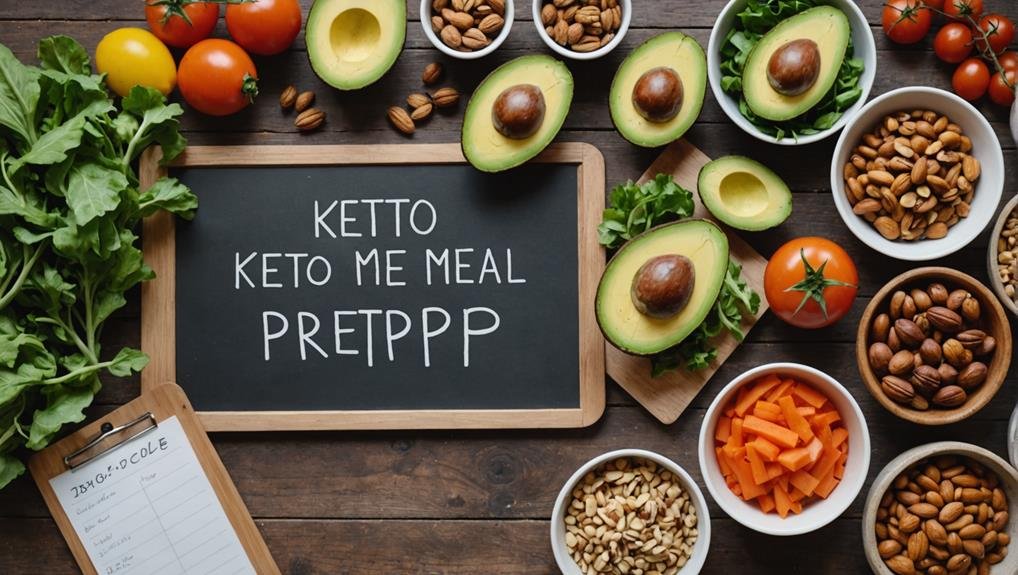To embark on a keto diet, prioritize a macronutrient ratio of high-fat (70-80%), moderate-protein (20-25%), and very low-carbohydrate (5-10%) foods.
Set a daily intake of 20-30 grams of net carbs to achieve ketosis, a metabolic state where your body burns fat for energy.
Carefully plan your meals by combining protein sources, such as chicken, with low-carb vegetables like spinach. Include healthy fats from sources such as olive oil and avocados.
To ease the transition and lessen the likelihood of experiencing 'keto flu' symptoms, gradually decrease your carbohydrate intake.
Maintain proper hydration and keep an eye on your electrolyte levels.
Utilizing macro calculators and engaging with online keto communities can provide valuable support and knowledge as you navigate your keto journey.
Key Takeaways
- Start by determining your macronutrient ratios, targeting approximately 70-80% of your daily calories from fats, 20-25% from proteins, and 5-10% from carbohydrates to effectively enter and maintain ketosis.
- Gradually lower your carb intake to between 20-30 grams per day to make the transition smoother and help lessen potential keto flu symptoms as your body adapts.
- Plan your meals in advance with a focus on low-carb proteins and healthy fats, ensuring you incorporate a diverse range of nutrient-dense foods to meet your nutritional needs.
- Keep yourself well-hydrated and consider supplementing with electrolytes to help alleviate any discomfort experienced during the initial adjustment phase of the keto diet.
Understanding Keto Basics
The ketogenic diet emphasizes a high-fat, moderate-protein, and very low-carbohydrate intake to induce a metabolic state known as ketosis. During ketosis, the body transitions from using glucose as its main energy source to utilizing fat for fuel, leading to the production of ketones in the liver, which serve as an alternative energy source.
Typically, a ketogenic diet comprises about 70-80% fat, 20-25% protein, and a mere 5-10% carbohydrates, often limiting net carb intake to 20-50 grams per day.
Low-carbohydrate diets, including the ketogenic diet, have gained traction not just for weight loss but also for potential health benefits. Many individuals experience improved blood sugar regulation and enhanced cognitive clarity when following a high-fat diet.
Effectively adopting a ketogenic lifestyle requires careful meal planning and tracking of macronutrients to ensure adherence to the desired ratios. Gradually decreasing carbohydrate intake is vital for easing into ketosis and minimizing potential side effects during the transition.
There are various types of ketogenic diets tailored to individual needs, including the Standard Ketogenic Diet (SKD), along with variations like the Cyclical Ketogenic Diet (CKD) and the Targeted Ketogenic Diet (TKD).
Familiarizing yourself with these foundational concepts will empower you to make informed decisions as you embark on your ketogenic journey, optimizing your strategy for effective weight loss and health improvement.
Essential Macro Guidelines
To successfully follow a ketogenic diet, you must adhere to specific macronutrient guidelines that emphasize fat consumption while minimizing carbohydrates.
The recommended macronutrient distribution for a standard ketogenic diet is around 70-80% fat, 20-25% protein, and 5-10% carbohydrates. Sticking to these ratios helps induce and maintain ketosis, a metabolic state where your body efficiently utilizes fat for energy.
When managing your carbohydrate intake, aim for approximately 20-30 grams of net carbs per day. This limitation supports your body's transition into ketosis, optimizing fat loss.
Additionally, it's crucial to monitor your protein consumption. Adequate protein intake is essential for preserving muscle and providing energy. However, be cautious not to exceed the suggested ratio, as excessive protein can convert to glucose and potentially disrupt ketosis.
Utilizing a macro calculator can greatly assist in tracking your macronutrients, allowing you to customize your fat, protein, and carbohydrate intake to suit your individual dietary requirements.
Gradually decreasing carbohydrate intake can ease the transition to a high-fat, low-carb diet and may reduce side effects, commonly referred to as the 'keto flu.'
Practical Meal Planning Tips

Planning your meals effectively is essential for staying on track with your keto diet while making it enjoyable and diverse. Start by selecting a protein source such as chicken, beef, or tofu, and pair it with low-carb vegetables like spinach, zucchini, or bell peppers.
Additionally, incorporate healthy fats, such as olive oil or avocado, to achieve the recommended macronutrient distribution of 70-80% fat, 20-25% protein, and 5-10% carbs.
Creating a weekly meal plan not only prevents meal monotony but also ensures your meals remain within the net carb limit of 20-30 grams per day. Consider meal prepping as part of your routine; preparing meals ahead of time not only saves time but also helps you consistently make keto-friendly choices.
Many keto recipes freeze well, which can simplify meal management during busier weeks. When shopping for groceries, prioritize fresh and high-quality ingredients, including keto-friendly meats, dairy products, and a variety of healthy fats.
Regular grocery shopping will fortify your meal planning throughout the week. To enhance your success, utilize apps or tools for tracking your food intake and monitoring your macronutrient distribution.
These resources provide valuable insights, helping you stay accountable to your keto goals.
Overcoming Keto Flu Symptoms
Keto flu symptoms can be particularly challenging during the initial week of the ketogenic diet. These symptoms may include fatigue, nausea, headaches, and irritability as your body transitions.
A crucial aspect of mitigating these symptoms is to monitor your electrolyte intake. Be sure to season your meals with salt and consider incorporating sea salt into your water. Additionally, foods high in sodium, potassium, and magnesium can be very beneficial.
Staying well-hydrated is vital in alleviating keto flu symptoms. Aim for a daily intake of at least 16 cups of water, as increased water excretion during ketosis can exacerbate discomfort.
Furthermore, gradually easing into the ketogenic diet by slowly lowering your carbohydrate consumption can help minimize the intensity of these symptoms. A sudden reduction can shock your system, making the adaptation process more difficult.
Paying attention to your body's hunger signals and consuming nutrient-dense foods is also important during this transition. Incorporate healthy fats, lean proteins, and a variety of vegetables to support your body and ease discomfort.
Additionally, maintaining optimal hydration will facilitate the adaptation process, helping you feel your best during this dietary shift.
Health Benefits of Keto

Starting a new diet can be daunting, especially when facing symptoms like the keto flu. However, understanding the numerous health benefits of the ketogenic diet can serve as strong motivation throughout your journey.
One of the most notable advantages of the keto diet is its effectiveness in promoting weight loss. Research indicates that individuals following a ketogenic diet may lose an average of 2 pounds more than those adhering to standard low-fat diets, making keto a viable option for those aiming to reduce body weight.
In addition to weight management, the ketogenic diet is known for its positive effects on blood sugar levels and insulin sensitivity. Studies have shown that it may reverse type 2 diabetes symptoms in up to 60% of participants. This is particularly significant for individuals looking to stabilize their blood sugar or who are concerned about diabetes risk.
The keto diet has also been associated with improved cardiovascular health, as it may help lower triglycerides and increase levels of beneficial HDL cholesterol; however, it's essential to monitor cholesterol levels regularly.
Many people on a keto diet report increased energy and enhanced mental clarity. The stable ketone production associated with ketosis might contribute to improved cognitive function and focus, making daily tasks easier to manage.
Emerging research also suggests that the ketogenic diet may have therapeutic potential in cancer treatment, reduction of Alzheimer's disease symptoms, and significant seizure control in children with epilepsy.
Finding Support and Resources
Finding support and resources is crucial as you embark on your keto journey. Connecting with others who share similar goals can provide motivation, inspiration, and practical insights. Here are some key resources to consider:
| Support Type | Resource | Benefits |
|---|---|---|
| Online Support Groups | Facebook, Reddit | Motivation, shared experiences, and tips |
| Keto Influencers | Instagram, TikTok | Meal ideas, recipes, and lifestyle tips |
| Macro Tracking Tools | Keto-specific apps | Simplified macro tracking and guidance |
| Keto Food Lists | Reputable websites | Easy grocery planning and meal prep |
Joining online communities, such as those on Facebook or Reddit, allows you to connect with individuals who can share their experiences, tips, and support as you navigate your keto journey. Following keto influencers on platforms like Instagram and TikTok can provide daily inspiration, new meal planning strategies, and innovative keto recipes.
Utilizing free keto food lists from trusted websites can help streamline your grocery shopping. Many of these resources also offer comprehensive meal prep guides, making it easier to stick to your dietary goals. Engaging in keto challenges or events within these communities can enhance your commitment and build camaraderie with others pursuing similar health objectives.
For tracking macros, consider using reliable apps like Wholesome Yum, which simplify the process and help keep you on track towards your goals. Collectively, these resources foster a supportive environment, making your dietary transition smoother and more effective.
Frequently Asked Questions
What Is the First Step to a Keto Diet?
The first step to starting a keto diet is to educate yourself about common misconceptions surrounding it. Begin by counting your carbohydrates while also researching healthy fat sources, planning your protein intake, and preparing delicious keto-friendly recipes in advance. Additionally, remember to stay hydrated to support your overall well-being during your transition to a ketogenic lifestyle.
How Can I Start Keto Diet on My Own?
To embark on your keto diet independently, consider these strategies: prepare meals in advance with keto-compliant recipes, create grocery lists featuring low-carb options, practice carb-counting techniques, and regularly monitor your progress to maintain motivation and address any plateaus you may encounter.
What Is the Best First Meal for Keto?
For an excellent first meal on a keto diet, consider enjoying scrambled eggs accompanied by avocado and cheese. These ingredients are prime examples of low-carb options that provide healthy fats and protein. Be sure to monitor your macros and practice portion control to ensure you stay on track with your dietary goals. This approach will help set you up for success on your keto journey!
What Not to Do When Starting a Keto Diet?
When starting a keto diet, it's crucial to avoid several common pitfalls. First, ensure you maintain proper electrolyte balance, as this can help prevent symptoms associated with the 'keto flu.' Second, be mindful of hidden sugars in foods that may disrupt your carb intake. Additionally, effective meal planning is essential to keep your diet on track. Resist the temptation of carb cravings by practicing portion control and making informed snack choices, especially when eating out.
Conclusion
Starting a keto diet introduces you to a diverse range of flavors and foods.
Understanding the key principles of the diet, monitoring your macronutrient intake, and carefully planning your meals are essential for a smooth transition.
While some individuals may encounter temporary discomfort during the adaptation phase, recognizing that it's a natural part of the process can help you manage it effectively.
Take advantage of the numerous health benefits the keto diet offers, and consider joining communities with like-minded individuals, as their support can enhance your experience and motivate you through even the toughest days of your keto journey.
